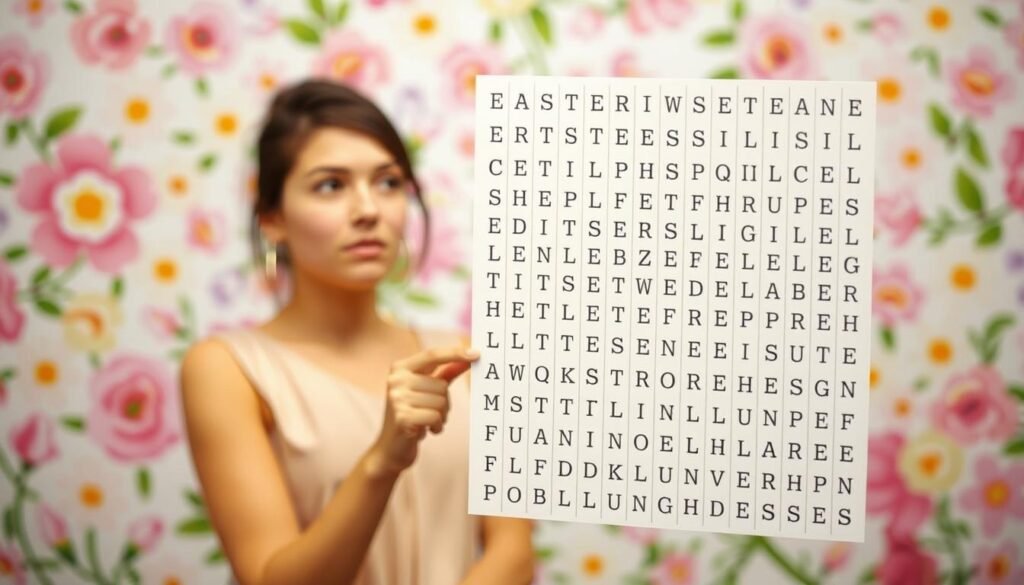Unleash the fun of Easter and spring with brain-boosting word search puzzles. These puzzles are designed for a mental workout. They engage minds while celebrating the season’s themes.
Perfect for a brain exercise, each puzzle book features over 100 holiday terms. Terms like “Easter eggs” and “bunnies” make play into purposeful learning.
Educators and families use these puzzles as a brain workout tool. They enhance focus and memory. Ideal for classrooms, spring break activities, or quiet time at home.
They offer a simple way to sharpen cognitive skills across ages. From kids to adults, solving these puzzles is a playful yet effective brain exercise.
Available on Amazon worldwide, this collection combines seasonal joy with cognitive challenges. The puzzles serve as more than just entertainment. They’re a gateway to sharper thinking and seasonal celebration.
The Brain-Boosting Benefits of Seasonal Word Search Puzzles
Seasonal word search puzzles turn fun games into brain workouts. They mix themes like Easter eggs and flowers to challenge the mind. This makes them a great way to keep the brain sharp for all ages.
How Word Searches Enhance Cognitive Function
Every word search game is a brain exercise. It uses visual, language, and problem-solving skills. This strengthens brain connections, like how exercise builds muscles.
Studies show these puzzles can slow brain aging in older adults. They also improve memory and quick thinking.
- Activates visual processing and vocabulary recall simultaneously.
- Encourages strategic thinking by prioritizing letter patterns.
- Shows measurable improvements in attention span over time.

Memory Improvement Through Pattern Recognition
Finding “daffodil” in a spring puzzle trains the brain. It helps with remembering things like directions or names. Seasonal puzzles make this practice more enjoyable.
- Players learn to associate words with visual layouts, boosting recall accuracy.
- Seasonal themes like Easter candy or spring flowers make practice feel less like a chore.
Focus and Concentration Training
Word searches require focus in a busy world. Finding “butterfly” in a spring puzzle sharpens focus. This skill helps with work or school tasks.
A 2021 study found daily puzzles like these reduce stress. They also improve mental clarity.
“Frequent mental challenges like word searches can delay cognitive decline by 2.5 years in older adults.”
Seasonal themes add fun, keeping the brain active. Whether online or on paper, these games make mental exercise fun.
Engaging Easter & Spring Word Search Helps to Workout and Master Your Brain
Easter word search puzzles are more than fun. They are a brain workout that sharpens your mind. These games challenge you to find hidden words in seasonal themes. This boosts your ability to see and understand shapes.
Each spring word search makes you focus on letter patterns. This strengthens your memory and quickens problem-solving. It’s a fun way to improve your brain skills.

Easter is America’s most popular holiday, making themed puzzles a perfect way to blend learning with celebration.
Doing these puzzles regularly builds new connections in your brain. For example, finding words like “blossom” or “carrot” in a spring grid helps you spot letter sequences quicker. It also helps you remember words better, which is great for kids.
Teachers and parents can make puzzles easier or harder. This ensures everyone gets a brain workout that fits their level. It’s a fun way to learn and grow.
- Visual scanning improves attention to detail
- Pattern recognition aids spelling and reading fluency
- Word searches stimulate dopamine release, making learning feel rewarding
Platforms like ABCYa and Digipuzzle have easter word search grids that meet educational standards. These tools help teachers add seasonal learning to their daily plans. By mixing brain challenges with holiday fun, these puzzles make learning a fun tradition.
How to Get Your Seasonal Word Search Puzzles
Easter & Spring Word Search Puzzle is available on Amazon, please click the links below to purchase your own copy
https://www.amazon.com/dp/B0DX7D5VKN (USA)
https://www.amazon.co.uk/dp/B0DX7D5VKN (UK)
How to Solve Word Searches More Effectively
Mastering a word search game starts with smart strategies. Whether tackling an printable word search for a classroom or a brain exercise at home, these tips streamline progress. Teachers often use seasonal puzzles like Easter or spring themes to boost student engagement, making learning a playful brain exercise. An printable word search with terms like “blossom” or “chicks” can transform routine practice into a festive challenge. Let’s explore proven methods to sharpen your solving skills.

Starting Right: Beginner Tactics
- Scan borders first—words often hide in edge rows.
- Start with short words to build momentum.
- Circle letters like Q, X, or Z to spot unique starting points.
Advanced Tips for Tough Puzzles
For complex grids:
- Check diagonals and backward sequences for Easter terms like “eggs” or “lamb.”
- Focus on long words first—they cover more grid space.
- Use a ruler to isolate rows and columns visually.
Beat Frustration with Simple Fixes
Stuck on a puzzle? Try:
- Color-coding found words to avoid repeats.
- Pausing briefly to reset focus.
- Highlighting rows with a ruler to avoid losing your place.
Every brain exercise strengthens problem-solving skills. Pair these techniques with Easter-themed puzzles to make practice fun and effective.
Easter-Themed Word Search Ideas and Vocabulary
Easter word search puzzles mix learning with fun. Use symbols like eggs, bunnies, and chicks. You can also include religious terms like resurrection and liturgy. Add foods like ham and chocolates for a tasty twist. Here’s how to make puzzles for all ages:
- Beginner Puzzles: Start with simple words like Easter basket or carrot in 36-letter grids.
- Advanced Puzzles: Use harder terms like paschal candle or alleluia in 100+ letter grids for teens.
- Interactive Elements: Add timers like those on 247 Word Search to track progress and boost focus.
“Holiday word search games help students build vocabulary while staying engaged,” says Ms. Carter, a 3rd-grade teacher using Easter-themed puzzles in her classroom.
Word placement is key: use left-to-right for beginners or diagonally for older learners. Harder puzzles might overlap words. For example, a holiday word search might hide lamb backward or lily vertically. Teachers can pair these with ABCYa’s Easter Egg Hunt games or Digipuzzle’s interactive grids, which align with K-3 learning standards.
Explore global Easter traditions, like Italy’s “Scavenger Hunt” or Mexico’s Monarch butterfly symbolism. This expands cultural awareness. Whether for faith-based classes or secular spring activities, Easter puzzles celebrate the season’s diversity.
Spring-Inspired Word Search Concepts for All Ages
Spring word searches turn curiosity into fun learning. They cover everything from crocuses to bees. These puzzles are great for school or family fun, making learning as exciting as a spring day.
Keep spring fever at bay with some egg-citing Easter movement and brain break activities for kids!
Early Spring Nature Vocabulary
Find the first signs of spring with words like crocus, daffodil, and robin. Kids can search for puddle or thaw. Teens can find more complex terms like vernal or pollination. These puzzles connect to science about life cycles or weather.
Weather and Seasonal Transition Terms
- Equinox: Mark the start of spring with astronomical terms.
- Melt and warming: Track seasonal shifts.
- Breeze or shower: Describe spring’s unpredictable skies.
Garden and Growth-Related Words
Grow your vocabulary with gardening terms like sow, germinate, and shears. Include tools like trowel or rake for a hands-on experience. Advanced puzzles can explore photosynthesis or perennials. Younger kids can enjoy simpler terms like seed or plant.
Creating Your Own Custom Holiday Word Search Puzzles
Turn holiday themes into fun learning tools with a few easy steps. These puzzles are great for school or family fun. Making your own holiday word search puzzles fits any group’s needs.
Tools and Resources for Puzzle Creation
Start with easy-to-use sites like Puzzle Maker or Discovery Education’s Puzzlemaker. These free sites help you make grids, pick words, and create easter & spring word search puzzle templates. For more design options, try Canva or Adobe Spark. Tools like WordMint offer print-and-play puzzles with different levels of difficulty.
Selecting the Perfect Word List
- Choose 10–15 words that fit holiday themes like spring (blossom, tadpole) or Easter (basket, resurrection).
- Match words with school goals, like ELA vocabulary or math terms.
- Use seasonal phrases like “spring breeze” for a challenge, and simpler words like “egg” for beginners.
Setting Appropriate Difficulty Levels
Change grid size for age: 12×12 for kids, 18×18 for older students. Add complex word hiding like diagonals or reverse. Use printable word search templates for easy changes. Test puzzles with a small group to make them clearer.
These tips make holidays learning opportunities. Share puzzles online or print them for homework or early finishers. With these tools, teachers and families can make fun activities that also teach important skills.
Easter and Spring Word Searches for Different Skill Levels
Check out word search collections for all skill levels. You’ll find easter puzzle sheets for beginners and spring puzzle grids for experts. Start with puzzles for young kids with easy words like “egg” or “bunny.” Move to harder puzzles with diagonal or backward words for older students.
- Beginner Level (Ages 4–7): Simple grids (36 letters) with words like “spring” or “candy.” Great for early literacy practice.
- Intermediate (Ages 8–12): Medium grids (64 letters) include terms like “hopping” or “daffodil,” encouraging problem-solving skills.
- Advanced (Teens & Adults): Expert grids (144 letters) hide words backward or diagonally, with terms like “equinox” or “hyacinth.”
“These puzzles transformed my classroom! Students love the easter puzzle variety while improving focus.” — Ms. Thompson, 3rd Grade Teacher
How to Get Your Seasonal Word Search Puzzles
Easter & Spring Word Search Puzzle is available on Amazon, please click the links below to purchase your own copy
https://www.amazon.com/dp/B0DX7D5VKN (USA)
https://www.amazon.co.uk/dp/B0DX7D5VKN (UK)
Conclusion
Easter & spring word search puzzles mix fun with brain exercise. They help improve focus and memory. These puzzles are like brain games that use patterns to make our brains stronger.
They are not just fun. They also help us think creatively. Whether you solve puzzles or make your own, they are great for your brain.
These puzzles are fun for everyone, no matter how old you are. They use words about flowers and holidays to keep you interested. The puzzles fit perfectly with the Easter season, making learning fun.
Studies show that learning actively helps us remember better. Schools and families can use these puzzles to help kids think better. It’s a fun way to learn.
It’s easy to find themed puzzles with ease. You can share these puzzles with friends or family. This makes learning together fun.
Adding these puzzles to your daily routine keeps your brain sharp. They are perfect for anyone who loves to learn or just wants to have fun. Easter & spring word search puzzles show that learning can be enjoyable.

